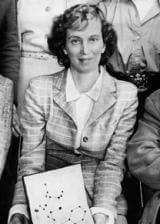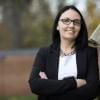Women in Science: Dorothy Crowfoot Hodgkin’s X-Ray Crystallography
Ask Science discusses the accomplishments of English chemist Dorothy Crowfoot Hodgkin. Her research in X-ray lasers led to revolutionary treatments for bacterial infections, Alzheimer’s, and diabetes.
Hi I’m Dr. Sabrina Stierwalt and I’m Ask Science bringing you Quick and Dirty Tips to help you make sense of science.
This weekend is International Women’s Day, a day for celebrating the contributions of women to our world and for drawing attention to the inequalities that women still face. So in that spirit, let’s brainstorm our favorite female scientists. I’ll give you a moment.
Hmmmm…
If you named Marie Curie and then got stumped, then you probably read the same history and science textbooks that I did in school. What about Rosalind Franklin, Mary Anning, Rachel Carson, or Grace Hopper? (Fun fact: all of those women were honored with Google Doodles over the last year.)
In the past, the work of female scientists may have been overlooked, but that is starting to change. One woman whose efforts are felt every time we go to the doctor with a bacterial infection or pop a B12 vitamin to promote a healthy brain is English chemist Dorothy Crowfoot Hodgkin.
Sponsor: Want to save more, invest for the future, but don’t have time to be a full-on investor? Betterment.com helps you build a customized, low-cost portfolio that suits your goals. Learn more.
Using X-rays to Crack Nature’s Codes
Dr. Hodgkin spent her scientific career as a chemist solving the structure of specific proteins and other biological molecules like vitamins and drugs by advancing the use of a technique called X-ray crystallography. Even before she was 30 years old, she was known as one of the most skilled X-ray crystallographers of her time. She determined how the different components of molecules fit together to form each molecule’s crystalline structure – a sort of high tech version of taking apart a watch to understand its inner workings.
To understand how X-ray crystallography works, we first have to understand diffraction.
You may have heard about the wave-particle duality of light, or the fact that light has both wave and particle-like properties. One way in which light behaves like a wave is by bending when it travels around edges or through slits, a process called diffraction. All waves do this – sound waves and water waves too.
See also: Super Powered Water
Check out this link for an easy experiment you can do at home to see the diffraction of candle light through a slit made by two pencils.
If we shine light waves on an object, we can observe the resulting diffraction pattern or the shadow left by the bending or spreading of the light as it passes through that object. The technique of X-ray crystallography does just that – a crystalline structure (like a protein) is bombarded by a very narrow beam of X-rays. The crystal then causes those light rays to diffract into many specific directions that depend on the make-up and structure of the crystal.

You can think of this decoding process like you would a Sudoku puzzle. While you can try to place numbers in certain boxes (or, in our case, atoms in certain formations within the crystal), ultimately, there is only one way the pieces can fit together to give you the final result.
The Pieces of the Penicillin Puzzle
Using X-ray crystallography, Dr. Hodgkin solved the structure of cholesterol in 1937, the structure of vitamin B12 (the largest and most structurally complicated vitamin) in 1956, and the structure of insulin in 1969, an endeavor she worked on for over 30 years!
Perhaps her greatest achievement, however, was solving the structure of penicillin in 1945. After doctors and scientists, starting with Alexander Fleming and Ernest Duchesne in the early 1900s, discovered that products of the mold called Penicillium could be used to effectively suffocate certain types of bacteria and keep them from multiplying, penicillin was soon being used to fight bacterial infections in people. Before the use of penicillin and other antibiotics, simple ear infections or even infected scrapes or cuts were potentially life threatening health issues.
The wonder drug still had its issues, however. Mass-producing penicillin was difficult and it had to be administered in large amounts since it was so easily excreted from the body. Roughly 80% of a dose of penicillin left the body only 3-4 hours after taking it. There was so much demand for the drug that doctors were even extracting it from patients’ urine to be reused! (Luckily, production is no longer so hard and we no longer have to resort to such recycling.)

Dorothy Crowfoot Hodgkin won a well-deserved Nobel Prize in Chemistry in 1964 for her efforts.
What other contributions from female scientists do you encounter every day? Share them with Ask Science on Facebook or on Twitter where I’m @QDTeinstein.
Until next time, this is Sabrina Stierwalt with Ask Science’s Quick and Dirty Tips for helping you make sense of science. If you have a question that you’d like to see on a future episode, send me an email at everydayeinstein@quickanddirtytips.comcreate new email.
Betterment LLC is an SEC Registered Investment Advisor. Brokerage services are offered by Betterment Securities, an SEC registered broker-dealer and member FINRA/SIPC. Investments are not FDIC Insured. No Bank Guarantee. May Lose Value. Investing in securities involves risks, and there is always the potential of losing money when you invest in securities. Before investing, consider your investment objectives and Betterment’s charges and expenses. Not an offer, solicitation of an offer, or advice to buy or sell securities in jurisdictions where Betterment and Betterment Securities are not registered.
Molecule and woman scientist images courtesy of Shutterstock. Dorothy Crowfoot Hodgkin image courtesy of ScienceMuseum.org.








